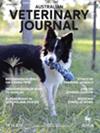Static anisocoria in cats and dogs with naturally occurring tick paralysis (Ixodes holocyclus)
IF 1.3
4区 农林科学
Q2 VETERINARY SCIENCES
引用次数: 0
Abstract
OBJECTIVE To characterise the novel occurrence and neuro-ophthalmological features of static anisocoria in cats and dogs with tick paralysis (TP) (Ixodes holocyclus) due to a single tick located remote from the head and neck. DESIGN Observational case series with retrospective analysis. METHODS Medical records were reviewed from 69 cats and 169 dogs treated for TP from a suburban veterinary hospital in Newcastle, New South Whales, between September 2005 and October 2021. RESULTS Anisocoria was observed in 2/18 (11.1%) cats and 3/30 (10.0%) dogs with a single tick located remote from the head and neck. These proportions were not different when compared within species to 4 of 28 (14.3%) cats and 16 of 98 (16.3%) dogs with aniscocoria with a single tick located on the head and neck region (P = 1 and 0.56 respectively). Anisocoria arose from pupillary efferent dysfunction and included unilateral oculoparasympathetic dysfunction (internal ophthalmoplegia) in one dog, unilateral oculosympathetic dysfunction (Horner's syndrome) in one cat and one dog, and a combination of bilateral, but asymmetric, oculosympathetic and oculoparasympathetic dysfunction in one cat and one dog. CONCLUSION It is proposed that anisocoria in cases of TP with a tick located remote from the head and neck is due to an intrinsic latent asymmetry in the safety factor for pupillary efferent function that is unmasked by a systemically distributed holocyclotoxin inhibiting neural transmission within this system, and this is the prevailing pathomechanism, rather than a direct local effect, underscoring anisocoria with a tick located on the head or neck.猫和狗的静止性不等角畸形伴自然发生的蜱麻痹(全环硬蜱)。
目的:研究猫狗蜱麻痹(TP)(全环硬蜱)的静止性不等角畸形的新发情况和神经眼科特征。设计:采用回顾性分析的观察病例系列。方法:回顾了2005年9月至2021年10月期间在新南威尔士州纽卡斯尔郊区兽医医院接受TP治疗的69只猫和169只狗的医疗记录。与28只猫中的4只(14.3%)和98只狗中的16只(16.3%)相比,这些比例在物种内没有差异(P = 分别为1和0.56)。嗅觉丧失是由瞳孔传出功能障碍引起的,包括一只狗的单侧眼交感神经功能障碍(内眼肌麻痹),一只猫和一条狗的单侧眼系统感觉功能障碍(霍纳综合征),以及一只猫一条狗的双侧但不对称的眼系统感觉和眼交感神经综合功能障碍。结论:有人认为,在远离头颈部的蜱虫TP病例中,不等径是由于瞳孔传出功能安全因子的内在潜在不对称性,而系统分布的全环毒素抑制了该系统内的神经传递,这是主要的病理机制,而不是直接的局部作用,用位于头部或颈部的蜱虫突出各向异性。
本文章由计算机程序翻译,如有差异,请以英文原文为准。
求助全文
约1分钟内获得全文
求助全文
来源期刊

Australian Veterinary Journal
农林科学-兽医学
CiteScore
2.40
自引率
0.00%
发文量
85
审稿时长
18-36 weeks
期刊介绍:
Over the past 80 years, the Australian Veterinary Journal (AVJ) has been providing the veterinary profession with leading edge clinical and scientific research, case reports, reviews. news and timely coverage of industry issues. AJV is Australia''s premier veterinary science text and is distributed monthly to over 5,500 Australian Veterinary Association members and subscribers.
 求助内容:
求助内容: 应助结果提醒方式:
应助结果提醒方式:


